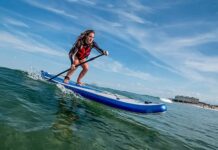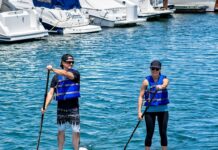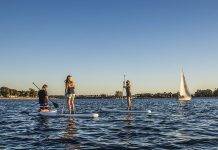We are here to introduce you to the world of SUP fitness! Have you ever wondered what it’s like to exercise on a paddleboard? Well, SUP fitness is all about just that. SUP stands for Stand-Up Paddleboarding, and it’s become a popular way to not only explore tranquil waters but also engage in a full-body workout. This unique form of fitness combines the benefits of traditional paddleboarding with various exercises that target your core stability, strength, and balance. Join us as we dive into the exciting world of SUP fitness and discover why it’s gaining popularity among fitness enthusiasts worldwide.
What is SUP Fitness?
Definition
SUP fitness, also known as stand-up paddleboard fitness, is a form of exercise that combines the serenity of stand-up paddleboarding with various fitness activities. It involves performing exercises and workouts on a paddleboard while floating on water. SUP fitness is a unique and engaging way to improve strength, balance, flexibility, and cardiovascular fitness.
Origin
The origins of SUP fitness can be traced back to Hawaii, where stand-up paddleboarding has its roots. Initially, stand-up paddleboarding was primarily used as a means of transportation for surfers to catch waves. Over time, it evolved into a popular recreational activity and eventually incorporated fitness elements. Today, SUP fitness has gained worldwide popularity and is practiced by people of all ages and fitness levels.
Benefits
Engaging in SUP fitness offers a multitude of benefits for both the mind and body. Firstly, it provides a full-body workout that targets muscles in the arms, shoulders, core, back, and legs. The continuous balancing required when paddleboarding engages various muscle groups, making it an effective way to improve strength and tone the body.
Furthermore, SUP fitness is low-impact, minimizing strain on the joints while still providing a cardiovascular workout. It helps improve cardiovascular endurance, leading to increased stamina and improved overall fitness. Additionally, being surrounded by nature and the calming water provides a therapeutic and stress-relieving experience, benefiting mental well-being.
SUP fitness also enhances balance, coordination, and flexibility. The unstable surface of the paddleboard challenges the body to continuously adjust and stabilize, thereby improving balance. A strong core is essential for maintaining balance while paddleboarding, making this activity an excellent way to strengthen the core muscles. Lastly, SUP fitness encourages greater mindfulness and focus, as it requires concentration and awareness of body movements.
Getting Started with SUP Fitness
Choosing the Right SUP Board
Selecting the right SUP board is crucial for a successful and enjoyable SUP fitness experience. There are several factors to consider when choosing a board, including length, width, volume, and construction material. Longer boards provide better stability, making them suitable for beginners, while shorter boards offer increased maneuverability for more advanced users. The width of the board should be sufficient to provide stability without compromising maneuverability.
Essential Equipment
In addition to the SUP board, there are several essential pieces of equipment required for SUP fitness. The most important equipment is a paddle, which should be the correct length and weight for an individual’s height and strength. A personal flotation device (PFD) is also essential for safety, especially when paddling in open water. Additionally, a leash and ankle strap are crucial to ensure that the paddleboard remains attached to the paddler in case of a fall.
Selecting the Right Location
When it comes to SUP fitness, selecting the right location is essential for a safe and enjoyable experience. Beginners should start in calm and flat water conditions, such as lakes, ponds, or sheltered bays, to avoid challenging conditions. It is important to consider factors such as water depth, current, and tides before choosing a location. Local regulations regarding SUP activities should also be taken into account to ensure compliance.
Basic Techniques
Learning and practicing basic paddleboarding techniques is essential before starting SUP fitness workouts. These techniques include proper paddling techniques, maintaining a balanced stance on the board, and turning the board. It is recommended to take paddleboarding lessons or seek guidance from experienced individuals to learn these techniques correctly. Practicing these techniques regularly will enhance the overall paddleboarding experience and allow for a smoother transition into SUP fitness workouts.
SUP Fitness Workouts
Full-body Workout
SUP fitness workouts offer a comprehensive full-body workout that engages multiple muscle groups simultaneously. Paddling against the resistance of the water works the upper body, including the arms, shoulders, and back. Balancing on the unstable surface of the paddleboard activates the core muscles, providing an excellent abdominal workout. The leg muscles are also engaged as they work to maintain balance and stability. By incorporating various exercises and movements on the paddleboard, such as squats, lunges, and planks, a complete full-body workout can be achieved.
Core Strengthening Exercises
SUP fitness is particularly effective for strengthening the core muscles. The core muscles, including the abdominals, obliques, and lower back, play a crucial role in maintaining balance and stability on the paddleboard. Performing exercises that target the core muscles, such as plank variations, Russian twists, and standing paddleboarding crunches, can greatly improve core strength. These exercises challenge the core muscles in a dynamic and functional manner, contributing to improved overall strength and stability.
Balance and Stability Training
One of the key benefits of SUP fitness is its ability to improve balance and stability. The continuously shifting surface of the paddleboard challenges the body to make constant micro-adjustments to maintain balance. This, in turn, strengthens the proprioceptive skills, which are responsible for spatial awareness and coordination. Incorporating balance-specific exercises, such as single-leg stands, yoga poses, and paddleboard lunges, into SUP fitness workouts further enhances balance and stability.
SUP Yoga
Combining SUP and Yoga
SUP yoga combines the tranquility of yoga with the dynamic and challenging nature of paddleboarding. Practicing yoga on a paddleboard adds an extra element of balance and stability, intensifying the experience. SUP yoga typically takes place on calm waters, allowing participants to connect with nature and find inner peace while performing yoga poses.
Benefits of SUP Yoga
SUP yoga offers numerous benefits, combining the physical and mental benefits of both yoga and paddleboarding. The water’s calming nature enhances the meditative aspect of yoga, allowing participants to experience a deeper sense of relaxation and mindfulness. The uneven surface of the paddleboard intensifies the engagement of core muscles, challenges balance, and enhances overall strength. Furthermore, SUP yoga provides a unique opportunity to reconnect with nature, fostering a sense of tranquility and well-being.
Common SUP Yoga Poses
SUP yoga incorporates a variety of traditional yoga poses modified to be performed on a paddleboard. Some common SUP yoga poses include the mountain pose, warrior pose, tree pose, downward dog, and child’s pose. These poses focus on enhancing balance, strength, flexibility, and relaxation. Performing these poses on the paddleboard adds an additional element of challenge, making the practice more dynamic and rewarding.
SUP Racing
Introduction to SUP Racing
SUP racing is a competitive sport that involves racing on a stand-up paddleboard. It has gained popularity worldwide, attracting participants of different ages and skill levels. SUP races can vary in distances and formats, from short sprints to long-distance marathons. SUP racing showcases a combination of paddleboarding skills, physical endurance, and tactical race strategies.
Different Race Formats
There are various race formats in SUP racing, each with its unique challenges and strategies. Sprint races involve short-distance sprints, testing speed and explosive power. Long-distance races require endurance and stamina as participants paddle for extended distances. Technical races incorporate buoy turns and obstacles, testing agility and maneuverability. Additionally, relay races and team events add an element of collaboration and teamwork to SUP racing.
Training for SUP Racing
Training for SUP racing involves a combination of paddleboarding practice, endurance training, and strength conditioning. Regular paddleboarding sessions help improve technique, balance, and stamina. Endurance training, such as distance running or swimming, helps build cardiovascular endurance. Strength conditioning exercises, such as resistance training and bodyweight exercises, enhance muscular strength and power. A well-rounded training program that combines these elements is essential for SUP racers to excel in the sport.
Safety Tips for SUP Fitness
Wearing Appropriate Safety Gear
When engaging in SUP fitness activities, it is crucial to wear appropriate safety gear. A personal flotation device (PFD) should be worn at all times, especially when paddling in open water or challenging conditions. The PFD ensures buoyancy and can be a life-saving device in case of an accident or fall. Additionally, wearing a leash and ankle strap is essential to keep the paddleboard attached to the paddler, preventing it from drifting away.
Understanding Weather Conditions
Before starting any SUP fitness activity, it is essential to understand and monitor the weather conditions. Wind, waves, and currents can significantly impact the safety and enjoyment of paddleboarding. Beginners should avoid paddling in strong winds or rough waters, as these conditions can make it challenging to maintain balance and control. Staying aware of local weather forecasts and understanding how to interpret weather patterns is crucial for a safe SUP fitness experience.
Practicing Proper Hydration and Nutrition
Proper hydration and nutrition are key to ensuring optimal performance and safety during SUP fitness activities. It is essential to stay hydrated before, during, and after paddleboarding, especially in warm weather conditions. Bringing water or hydrating beverages and consuming them regularly is recommended. Additionally, fueling the body with nutritious snacks before and after workouts helps maintain energy levels and aids in muscle recovery.
Choosing the Right SUP Board
Types of SUP Boards
There are various types of SUP boards available, each designed for specific purposes. All-around boards are versatile and suitable for beginners, recreational use, and a wide range of paddleboarding activities. Touring boards are longer and designed for longer distances and more challenging conditions. Surfing boards are shorter and maneuverable, specifically designed for surfing waves. Race boards are narrower and faster, optimized for speed and efficiency in SUP racing.
Considerations for Selecting a Board
When selecting a SUP board, it is important to consider factors such as skill level, intended use, body weight, and paddling conditions. Beginners should opt for wider and more stable boards for easier balance and control. Advanced paddlers may choose narrower and faster boards for increased speed and performance. The weight capacity of the board should also be considered, ensuring it can support the paddler’s weight comfortably.
Inflatable vs. Solid Boards
One of the decisions to make when choosing a SUP board is whether to opt for an inflatable or a solid board. Inflatable boards are made of durable PVC material and can be inflated and deflated for easy transportation and storage. They are lightweight, highly portable, and ideal for travel. Solid boards, on the other hand, are made of rigid materials such as epoxy or fiberglass and offer superior performance and durability. They are typically more responsive and suitable for users seeking maximum performance.
Essential Equipment for SUP Fitness
Paddle
A high-quality paddle is an essential piece of equipment for SUP fitness. Paddles can vary in weight, length, and blade size, and choosing the right paddle is crucial for an efficient and comfortable paddling experience. It is important to select a paddle that is the correct length, with the blade size and shape that complements the individual’s paddling style and strength. Lightweight and adjustable paddles are recommended for ease of use and convenience.
Personal Flotation Device (PFD)
A personal flotation device (PFD) is a crucial safety equipment that should be worn by all paddleboarders, including those engaging in SUP fitness. It provides buoyancy and can be a life-saving device in case of accidents or falls. PFDs come in various designs, including inflatable waist belts or traditional flotation vests. It is important to choose a PFD that fits properly and is comfortable to wear for extended periods.
Leash and Ankle Strap
A leash and ankle strap are vital equipment for SUP fitness to ensure the paddleboard remains attached to the paddler in case of a fall. The leash is attached to the paddleboard’s tail and worn around the ankle, ensuring that the board stays close and within reach. This prevents the board from drifting away and minimizes the risk of accidents or losing the board in challenging conditions. Leashes typically come in different lengths and styles, and it is recommended to select one that is appropriate for the paddler’s specific activity and conditions.
Selecting the Right Location for SUP Fitness
Body of Water
Choosing the right body of water is essential for a safe and enjoyable SUP fitness experience. Beginner paddlers should start in calm and flat water conditions, such as lakes, ponds, or sheltered bays, to avoid strong currents or waves. Experienced paddlers may venture into more challenging conditions, such as rivers or coastal areas, but should have the necessary skills and knowledge to handle these environments. It is important to consider factors such as water depth, temperature, and cleanliness when selecting a body of water.
Access and Parking
Access to the chosen location is an important consideration when planning a SUP fitness session. Ensure that there is convenient access to the water, ideally with a launching area or dock. Ample parking space is also important, especially if the location is popular or requires a permit. It is helpful to research and inquire about parking regulations or fees in advance to avoid any issues on the day of the activity.
Local Regulations
Before embarking on SUP fitness activities, it is crucial to understand and adhere to local regulations concerning paddleboarding. Some bodies of water may have specific rules and regulations regarding watercraft activities, including SUP. Familiarizing oneself with these regulations helps ensure safety and compliance with local laws. Regulations may include restrictions on certain areas, speed limits, required safety equipment, and permits required for certain activities.
Pre and Post-Workout Meal Ideas for SUP Fitness
Energizing Breakfast Options
Before a SUP fitness workout, it is important to fuel the body with a balanced and energizing meal. Some ideal breakfast options for SUP fitness include oatmeal topped with fresh fruits and nuts, whole grain toast with avocado and eggs, or a smoothie made with a combination of fruits, vegetables, and protein powder. These meals provide a good balance of carbohydrates for energy, protein for muscle repair, and healthy fats for sustained energy.
Light and Nutritious Snacks
During prolonged SUP fitness activities, it may be necessary to refuel with light and nutritious snacks to maintain energy levels. Some great snack options for SUP fitness include trail mix, energy bars, fresh fruit, or nut butter with whole grain crackers or rice cakes. These snacks provide a combination of quick-release and slow-release energy sources to sustain energy levels throughout the workout without causing discomfort or a heavy feeling.
Replenishing Post-workout Meals
After a SUP fitness workout, it is important to replenish the body with nutrients for muscle recovery and replenishment. Some recommended post-workout meals include grilled chicken or tofu with roasted vegetables and quinoa, a salmon and avocado salad, or a protein-rich smoothie with Greek yogurt, berries, and spinach. These meals provide a good balance of protein, carbohydrates, and healthy fats to aid in muscle recovery and replenish energy stores. It is also important to hydrate properly by drinking water or electrolyte-rich beverages to replace lost fluids.





































